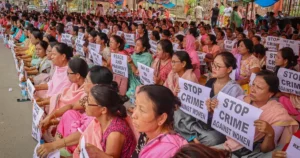Subject:
- GS-2: Governance & Federalism – President’s Rule, Law Enforcement, Centre-State Roles
- GS-3: Internal Security & Conflict Management – Ethnic Disputes, Insurgency, Militant Groups

Key Points
President’s Rule and Actions
- The BJP-led Manipur government was dissolved, with President’s Rule enacted to stabilize the region.
- Replacing N. Biren Singh has proven difficult due to entrenched ethnic divides.
- A deadline was set for non-State groups to surrender weapons looted from police armories.
Obstacles to Stability
- Ethnic tensions persist, with resistance to government initiatives widespread.
- Of over 3,000 missing weapons, mostly stolen from Imphal Valley, only a third have been retrieved.
- Clashes in Kangpokpi district over free vehicle movement enforcement left one dead and over 40 injured.
Kuki-Zo Demands & Tensions
- Kuki-Zo groups seek Union Territory status or a separate region, heightening conflict.
- Naga communities reject these demands, risking further ethnic clashes.
- Dialogue is needed, but violent or unfeasible demands must be dismissed.
Insights & Next Steps
- Complete disarmament of non-State actors is critical to reducing violence.
- The State must assert sole authority over weapons through consistent messaging.
- Direct engagement by PM Modi and the Home Ministry with communities could foster peace and economic revival.
Mains Practice Question
“Evaluate the consequences of imposing President’s Rule in states with ethnic conflicts. How can the government promote peace and stability while upholding constitutional norms?”




